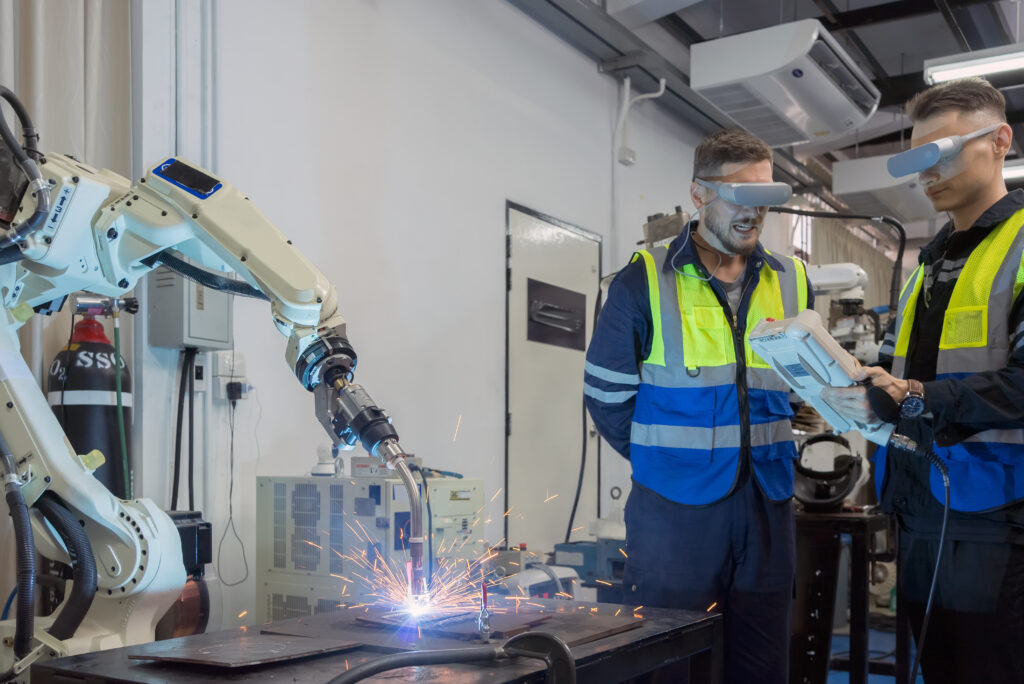- Tech job postings on Indeed plunged after a post-pandemic boom and have been quite weak since mid-2023. As of early July 2025, they were down 36% from their early-2020 levels. Some observers link this trend to a hangover from the earlier boom, while others emphasize that artificial intelligence (AI) could be reducing demand for tech workers.
- There isn’t a smoking gun linking the plunge to the rise of AI. Nearly half of the net decline in tech postings from their peak occurred before Chat-GPT 3 went public, and tech postings have eased similarly to the rest of the economy since late 2023. However, AI could be a reason tech postings haven’t rebounded from their low levels.
- Local-level trends suggest broader economic conditions have had an impact, as tech job postings aren’t down as sharply in markets where non-tech postings have also been stronger (e.g., Atlanta, Austin).
- At the same time, the AI revolution is apparent in types of tech jobs still in demand: Jobs directly related to AI, such as machine learning engineers, are among the few tech jobs with postings still above early-2020 levels.
- The number of people working in tech and mathematics occupations ticked down in 2024, but remained quite elevated, highlighting how, so far, the hiring freeze has impacted tech job seekers more than employment itself. However, these diverging conditions can likely only persist for so long.
Editor’s Note: This is part of a series of pieces examining employment trends in the tech sector. For more on changes to the experience required of tech employees in recent years, please see our companion piece here.
As of mid-2025, the US tech hiring freeze has entered its third year, a sea change from the booming conditions that prevailed before. US job postings for tech and mathematics occupations on Indeed — which account for 3.6% of total US postings in July 2025, covering hundreds of job titles ranging from software engineers, quality assurance analysts, helpdesk technicians, and data scientists — soared in the aftermath of the pandemic, peaking in early 2022 at more than double their February 2020 level. However, as the economic situation turned and the Fed began hiking interest rates, the pull-back in demand was just as sharp. Tech postings plunged through the end of 2023 and have edged lower since; on July 11, 2025, they stood 36% below their February 2020 level.
Two main explanations have been offered for the crash in demand for tech workers. One is that the sector is experiencing an overhang from its earlier hiring boom, aggravated by less supportive economic conditions — including the end of the “zero interest rate period” — with some resemblance to trends in the broader economy. Swings in total US job postings haven’t been as dramatic as for tech jobs themselves, but have been substantial.
The other candidate is that the recent AI revolution has significantly reduced interest in hiring new tech workers. Indeed research has found substantial overlap between the capabilities of existing GenAI tools and many of the skills and tasks listed in US tech job postings. As a result, automation of some of the tasks performed in these roles could be driving their drop in job postings.
Timing makes it tough to pinpoint AI’s role in the tech posting decline
Tech job postings were already plunging before the dawn of the new AI age. In fact, nearly half of the net decline in tech postings between their peak and July 2025 occurred before the public release of Chat GPT-3 in late 2022. The rapid decline then continued through the first half of 2023, as use of GenAI was still in its infancy. Given the downward trend was already well underway, it’s tough to gauge whether these brand-new tools immediately impacted hiring appetite.
Another possibility is that the drag of AI on tech job postings has been more gradual and ongoing, which could cause tech job postings to increasingly lag other occupations over time. However, while tech postings have eased further since mid-2023, so too have economy-wide job postings, including among occupations with relatively low near-term GenAI replacement risk (such as food services, manufacturing, and nursing). As a result, with the exception of a slight slip in early 2025, the ratio of tech postings relative to postings for low-AI exposure jobs has held fairly steady since late 2023.
On the surface, similar recent trends in tech and non-tech postings suggest macroeconomic developments remain a key driver of posting trends for both categories of workers, consistent with the overhang theory of the tech plunge. However, this doesn’t mean the rise of GenAI hasn’t had an impact. Tech postings might have rebounded relative to the rest of the economy were it not for GenAI’s automation potential. Even if the new technology wasn’t the cause of their initial decline, it could be preventing a bounce-back.
Local tech posting trends share similarities with other occupations within their region
Between early 2020 and 2025, tech postings slumped across nearly all US urban areas — but by different degrees. One sign that some of the weakness was related to the broader economic situation, rather than just a tech-specific shock, is that within localities, the extent of tech declines was correlated with how non-tech postings fared over the same period.
For example, in Austin, tech postings in early 2025 were down 28% compared to their pre-pandemic level, while in Boston they had plunged 51%. However, a gap was also apparent for non-tech jobs: Over the same period, non-tech postings were still up 11% in Austin, compared to an 8% decline in Boston.
This pattern has been fairly consistent across large metro areas: Non-tech job postings are at or above pre-pandemic levels in the places where tech postings have held up better, often in Texas and the Southeast. Meanwhile, most of the large markets where tech postings have plunged over 40% compared to pre-pandemic levels — including Seattle, Minneapolis, and San Francisco — have also experienced substantial declines in non-tech postings.
The correlation between tech and non-tech posting trends at the metropolitan level could reflect several factors. One is that employer sentiment about local conditions influences hiring appetite for tech and non-tech postings alike, on top of broader industry and macroeconomic drivers. Interestingly, one metro where tech postings have held up better than we’d expect based on falling non-tech postings has been the San Jose area, which happens to be the center of the rise of GenAI job postings.
Postings for AI-related roles are among the few tech job titles still up, compared to early 2020
As of early 2025, postings were down from pre-pandemic levels among most tech job titles. Of the 149 tech titles with at least 1000 postings in early 2025, only 28 (19%) exceeded their pre-pandemic level, while almost the same number of titles had dropped by over 40%, including software engineers, still the most common tech job title (down 49%). Declines were especially sharp among jobs in the middle of the tech wage-spectrum (as measured by 2024 posted salaries), including for several types of specialized developers, such as Android, Java, .Net, and iOS, as well as web developers — all down by over 60% compared to early 2020.
Many of the positive exceptions to the broad decline have been among AI-related tech jobs. Postings for Machine Learning Engineers — the quintessential AI role — have fallen from their early 2022 peak (-47%), but by far less than other tech jobs, and remain up 59% from early 2020. Other variants of the role, like “AI/ML engineer,” a job title that was previously rare, have done even better. SAP consultants and leads are both standout roles that support the adoption of technology across a wide range of businesses.
Strong demand for AI-related tech titles is also reflected in their pay. Posted annual salaries for jobs like machine learning engineer (2024 median of $260,000) often rank among the highest of common tech jobs. However, one exception to this pattern is among postings for data center technicians, which have also soared in demand amid the rise of GenAI.
Tech employment is still elevated despite hiring freeze
Hiring appetite for new workers might have plunged, but the number of people working in tech and mathematics occupations remains quite elevated, according to the Bureau of Labor Statistics’ (BLS) Current Population Survey. While employment in these occupations ticked down 2% in 2024, it was still up 19% from their 2019 level, far outpacing the 2.4% economy-wide growth over the same period. Within the computer and mathematics category, the BLS’s 2024 Occupational Employment and Wage Statistics (which provides greater detail, but is less precise for year-to-year changes) reports areas of recent weakness (web developers, computer programmers), and strength (data scientists), as well as relative stability among the most common tech occupations (software developers and computer support specialists).
Relatively steady overall tech and mathematics employment amid the plunge in job postings highlights the diverging conditions facing tech job seekers and tech workers. Despite some high-profile layoffs, the share of the US workforce employed in these roles is elevated, while pay remains solid. But the situation is bleaker for those looking to enter the field, and opportunities for tech workers to change jobs have shrunk, which, along with tighter experience requirements, has hit the prospects of early-career professionals.
At some point, conditions facing tech job seekers and workers will likely re-converge, but in what direction? That will partially depend on the combination of forces behind the current depressed state of tech hiring appetite, which itself is difficult to pinpoint. A substantial fraction of the initial plunge in tech postings was likely related to the boom-bust nature of the cycle, and some of those forces have probably persisted. However, if AI-related automation is a key reason tech postings haven’t rebounded more recently, then overall employment in the field could shift from its recent downtick to more substantial declines.
Annex: Tech titles with the largest increases/decreases in job postings since 2020
Methodology
For the purposes of this post, job postings for tech and mathematics occupations refer to job titles classified as one of the following occupational categories according to Indeed’s taxonomy structure: software development, information design and technology, IT operations and help desk, and mathematics. These categories include many management positions, but might miss some tech-related job titles that are classified under the “management” occupational category.
Occupational categories included in as “lower GenAI exposure” jobs include: Physicians & Surgeons, Childcare, Cleaning & Sanitation, Installation & Maintenance, Nursing, Construction, Personal Care & Home Health, Driving, Production & Manufacturing, Food Preparation & Service, Beauty & Wellness, based on the findings of earlier Indeed research.
Time series data in this post is presented as 7-day moving averages, seasonally adjusted, while cross-sectional data is not seasonally adjusted.
Employment data shown is annual average employment levels according to the BLS’ Current Population Survey, computer and mathematical occupations (code 15-0000).
The number of job postings on Indeed, whether related to paid or unpaid job solicitations, is not indicative of potential revenue or earnings of Indeed, which comprises a significant percentage of the HR Technology segment of its parent company, Recruit Holdings Co., Ltd. Job posting numbers are provided for information purposes only and should not be viewed as an indicator of performance of Indeed or Recruit. Please refer to the Recruit Holdings investor relations website and regulatory filings in Japan for more detailed information on revenue generation by Recruit’s HR Technology segment.



